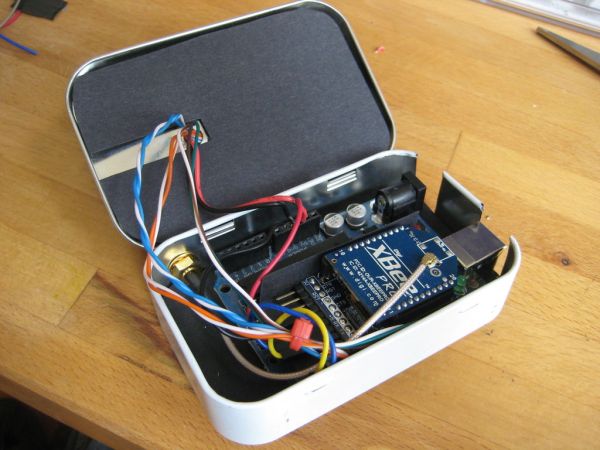This Instructable will show you how to modify an Altoids tin for a wireless 2×16 character display.
Using an Altoids tin was inspired by the need to have a small yet protective enclosure for a pair of Xbee modules recently bought from Sparkfun. I purchased the Xbee Pro modules with external antenna for the extended range the setup provides (useful for future projects). Then I realised I would need to mount the antenna socket and have a box to house the circuits.
A L T O I D S !
Overall Configuration
There will be a ‘remote’ Altoids tin containing Arduino, LCD and Xbee module.
A second Altoids tin containing an Xbee module only. This connects to the PC with a USB to FTDI serial cable.
Data is sent from the PC using a terminal program such as the Arduino ‘Serial Monitor’ and appears on the Altoids display.
So here are some possible ideas for use with this setup:

(Data flow PC to Wireless Display)
– Email Notifier
– RSS Feeds
– Facebook/Twitter Updates
– Realtime Clock
(Data flow Wireless Display to PC)
– Weather Station
– Speedometer
– Engine Monitoring
– Heart Rate Monitor
– Other realtime data logging
Let’s get started!
Step 1: Components & Tools
So here’s a list of what you’re going to need for this project:
– – – – – – – – – – – – – – – – – – – – – – – – – – – – – – – – – – – – –
A) Featured P2P Wireless Setup
– (2x) ALTOIDS TIN
– (1x) Arduino Duemilanove
– (1x) 2×16 LCD HD44780
– (4x) Hex Posts/Spacers
– (4x) Matching Screws
– Form of sheet insulation (Card / Foam etc.)
– (2x) Xbee Modules (U.FL antenna connector)
– (2x) U.FL to RP-SMA cable connector
– (2x) Adafruit Industries Xbee Adapter Kit
– (2x) RP-SMA 2.4Ghz Duck Antenna
– (1x) USB type A to type B
– (1x) USB to serial FTDI
– Cat5 Cable
– – – – – – – – – – – – – – – – – – – – – – – – – – – – – – – – – – – – –
I realise that the Xbee modules can be quite costly.
If you still want wireless and you’re content with one-way communication then there are alternative radio modules such as these from HopeRF:
http://shop.jeelabs.com/products/rfm12b
I think it’s worth mentioning that this project can still be effective without wireless communication so why not create a neat USB desktop widget?
B) USB Version Only
If you just want to create a USB Altoids Message Display you’re going to need:
– (1x) ALTOIDS TIN
– (1x) Arduino Duemilanove
– (1x) 2×16 LCD HD44780
– (4x) Hex Posts
– (4x) Matching screws
– (1x) USB type A to type B
– Cat5 Cable
– Form of sheet insulation (Card / Foam etc.)
– – – – – – – – – – – – – – – – – – – – – – – – – – – – – – – – – – – – –
Tools Needed
– Soldering iron & solder
– Needle-nose pliers
– Scissors
– Tin snips
– Marker pen
– Wire strippers
– Cross head screwdriver
– Fine grade sandpaper
– Drill & bits 3mm + 6.5mm
Step 2: Prepare the surface…
As iconic as the Altoids graphics are, I found that I quite liked the ‘brushed’ metal look.
Take some sandpaper and begin wearing away the top layer of paint.
(The finer the grade of sandpaper, the smoother the finish)
Step 3: Mark & drill holes
You will need to mark out and drill 6x holes in total.

1. Place the the LCD over the top surface and mark 4x holes (3mm)
Alternatively you could create a cardboard template to be more accurate.
2. Use a larger, 6mm drill for the antenna socket.
I chose to mount the socket on the back left on the tin as this would allow the antenna to be folded down parallel to the case for storage.
3. The final 6mm hole (underneath display) will allow the wires from the LCD to pass through to the inside.
NOTE: Be patient when drilling these holes through the metal. I found that the best solution was to use a combination of a high speed setting and slow movement into the material. If you’re too quick, you can easily deform the metal.
– (1x) Arduino Duemilanove
– (1x) 2×16 LCD HD44780
– (4x) Hex Posts/Spacers
– (4x) Matching Screws
For more detail: Wireless Altoids Display using an Arduino
